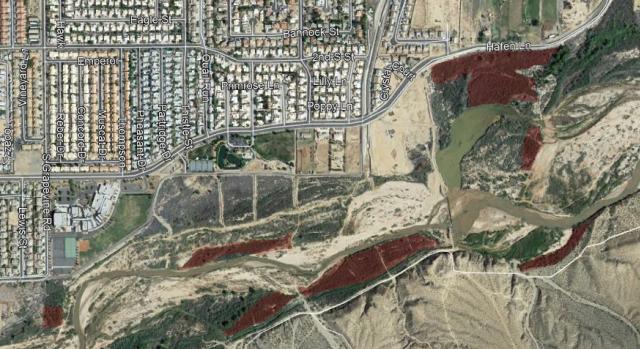Bureau of Land Management to begin removing invasive tamarisk along Virgin River near Mesquite
Organization:
BLM Office:
Media Contact:
LAS VEGAS – As part of the Virgin River Coalition’s effort to restore areas of the Virgin River near the City of Mesquite, Bureau of Land Management (BLM) will reduce dense thickets of invasive tamarisk (aka salt cedar) trees between March 29 and April 15.
The project aims to reduce the risk of severe wildfire, restore native streamside cottonwood, willow and ash that provide food and shelter for wildlife.
Tamarisk are highly flammable, displace native plants and increase the concentration of salt in the upper layers of the soil which further limits the recovery of less salt-tolerant native plants.
“We are excited to move from planning to on-the-ground efforts,” said Shonna Dooman, Las Vegas Field Office Manager. “As part of the Virgin River Coalition, we are eager to begin efforts that will both reduce fire risk for the City of Mesquite and restore the streamside to native vegetation.”
The initial phase will last about one to two weeks as heavy equipment grinds down the tamarisk into small chunks of wood that will be left onsite to act as a mulch to help establish native plants.
Temporary detours on Hafen Drive, the Riverside Trail and other popular UTV trails will be likely during this phase to ensure safety as machinery operates as it can throw wood debris a considerable distance.
About a year later, the National Park Service Invasive Plant Management Team will treat tamarisk re-sprouts and any other non-native invasive plants using small amounts of herbicide approved for use in sensitive aquatic environments.
During the final phase, seedlings being grown at Lake Mead National Recreation Area’s Song Dog Native Plant Nursery will be planted by a combination of paid restoration workers and volunteers. Biodegradable tubes and wire mesh cages will be placed around saplings to protect them from rabbits and other herbivores until the plants and trees are large enough to fend for themselves and begin to compete with any non-native plants that try to recolonize. Some saplings will need supplemental watering, weeding and other care for two to three years.
The BLM manages about 245 million acres of public land located primarily in 12 western states, including Alaska, on behalf of the American people. The BLM also administers 700 million acres of sub-surface mineral estate throughout the nation. Our mission is to sustain the health, diversity, and productivity of America’s public lands for the use and enjoyment of present and future generations.

